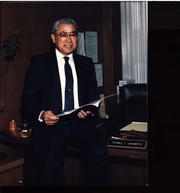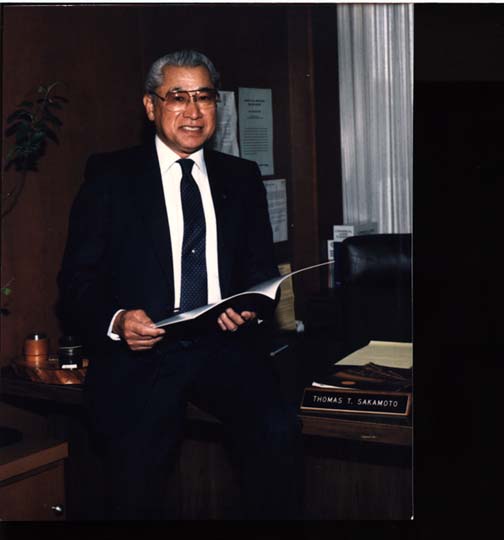
Banco de Dados da Experiência Militar Nipo-Americana

Thomas T. Sakamoto
MILS Staff and Faculty, Camp Savage, MN
ATIS, Australia
Occupation of Japan, Tokyo
Ryukyu Islands
JUSMAG, Thailand
Vietnam
Language Instructor
Advisor to Thailand Army
General Staff, etc.
Other countries: Australia, Korea, Japan, Thailand, Vietnam, Philippines
Chronology as follows:
2/1941: Drafted at age 22. Presidio of Monterey, CA.
10/1941: Army Language School (Secret). Presidio of San Francisco, CA. 6 month school.
5/1942: Camp Savage, MN. Staff and faculty (graduated).
6/1942: S/Sgt.
11/1943: Australia - South West Pacific Theater (SWPA). MacArthur command.
2/1944: Admiralty Islands. Los Negros invasion with 1st Cavalry (Hyanne Harbor). Departed at dawn from Oral bay on 9 destroyers 2/27.
7/1944: T/Sgt.
5/1945: M/Sgt.
6/1945: Warrant Officer Junior Grade (WOJG)
8/1945: 2nd Lt.
1/1946: 1st Lt.
8/1945: Landed with MacArthur at Atsugi Naval Base (First US Forces).
1947-1949: Occupation of Japan. LtC Paul Rush, Economic Scientific Service (ESS) GHQ.
10/1952: Captain.
1953-1956: 3 months Korean War. Then assigned to Security Group, as National level US Army Foreign Intelligence Officer with Government of Japan for US Far East Command, Japan.
1958-1961: Military Language Aide and Political Analyst to High Commissioner for Ryukyu Islands.
11/1960: Lt. Colonel.
1961-1964: Chief, Security of Military Information Branch, Office of Deputy Chief of Staff, Intelligence HQ, 6th Army, Presidio of San Francisco.
1964-1968: Chief, Military Security Division, Office of Deputy Chief of Staff, Intelligence HQ, 6th Army, Presidio of San Francisco.
1964-1966:JUSMAG US Army Intelligence Officer and Advisor to Director of Intelligence, Royal Thai Army, Bangkok, Thailand.
1968-1969: Vietnam War. Chief, Counter-intelligence Division, Assistant Chief of Staff, G-2, HQ, US Army, Vietnam.
3/1969: Colonel.
1/1970: Retired.
Bronze Star (2 awards)
Legion of Merit
1963 - B.A. Degree, San Francisco State College, Major - Social Science
Defense Language Institute, Monterey. Russian, 1 year, 1949-1950. Thai Language, 3 months, 1964.
1950-1954 - Instructed Japanese Language Classes
Military - Combat, strategic and counter-intelligence
1973-1974 - Graduate Studies in Asian History, San Jose State University.
EXPERIENCE
Military - Over 28 years of active military service including 11 years overseas duties in the Far East. See under 'Personal Responsibilities' for duties.
BANKING
Joined Crocker Bank as officer trainee in 1970, specializing in loans. In 1975, joined Sumitomo Bank. Promoted to Assistant Manager in 1977, Assistant Vice President in 1978, in the San Jose Branch; Vice President and Manager, Cupertino Office, 1978; and Senior Vice President and Manager, Sumitomo Bank, San Jose; retired in June 1985.
COMMUNITY PARTICIPATION
First (Founding) President, Military Intelligence Service, Northern California - 1970
Kiwanis Club, San Jose - 1977-1978
Vice President and Director of Cupertino Chamber of Commerce - 1980-1983
Cupertino Rotary Club (VP International) - 1980-1983
Advisor, San Jose JACL - 1984-2001
San Jose Rotary Club - 1984-1990
Santa Clara County Grand Jury (Chair - Judicial) - 1985-1986
President, San Jose Nihon Machi - 1985-1992
Board of Director, National Japanese American Historical Society - 1990-1998
President, National Japanese American Historical Society - 1996-1998.
HOBBY
Golf
ADDITIONAL INFORMATION
Col. Sakamoto had prepared a autobiography of his early childhood, military experience and business experience after retiring. Excerpts are included below. If you have further interest, please request a copy of the complete autobiography from the librarian in the Hirasaki National Resouce Center at the Japanese American National Museum.
My father ran a boarding house in San Jose Japan town. In those prewar days, Isseis were prohibited from owning land and most families struggled to eke out their livelihood on the farm and barely survived. They had large families. I'm the second oldest son among eleven children.
Through economic necessity, Issei stuck together, helping each other build simple houses, often borrowing horses to plow the fields and helping with labor. There was a genuine spontaneous mutual help spirit among the families. Our community and social life was centered around the Buddhist Church, Wesley Methodist Church, JACL, Kenjin-kai, Asahi Baseball and Sumo. Entertainment was the periodic silent Japanese movies narrated by a 'benshi' at the local Okita Hall.
I was sent in 1934 to Japan for education, being the older son. I was a junior at Santa Clara High School at the time. I went to Kumamoto, Japan for four years of 'chugakko' education from 1934 to graduation in 1938. Our school was one of the pioneer Christian schools in Japan and is prominent today.
I was housed at a teacher's home who happened to be the kendo instructor. I became quite proficient at kendo and attained the 'nidan' rank after returning to the states.
After returning to the states, I began to farm. However, just as farm life was gradually taking shape, I received a draft notice to report for induction.
During manuevers at Hunter Legget army base, a friendly-looking man in civilian clothes with a heavy Swedish accent asked me to read and translate a book which turned out to be a Japanese manual on military tactics. I later learned that he was Captain Rasmussen, who became the commandant of the first secret Army Language School at the Presidio of Monterey. He was impressed with my knowledge of Japanese and asked me to attend and complete a one year course. 58 Niseis and 2 Caucasians reported to the school. 42 of us graduated and were assigned to three classes. After Pearl Harbor the course intensified. 29 students were quickly sent to combat areas from Alaska, Guadalcanal and Australia. In combat, commanders were initially reluctant to use Nisei linguists, but with the increase in the number of Japanese prisoners-of-war and the valuable information gained, they quickly came to appreciate their value.
I volunteered for combat duty and was sent to Brisbane, Australia and later, at New Guinea, joined the 1st Cavalry Division for the invasion of Los Negros Island in the Admiralty Group. Captured enemy documents were translated to determine target locations that were subsequently attacked. After the battle for Los Negros was won, I flew immediately to Hollandia, New Guinea. I received a Bronze Star for my efforts at Los Negros but it is interesting to note that the citation in the National Archives had a 'blank' for my name, because of the secrecy then imposed on the Nisei in the Pacific.
The Niseis were promised commissions but never received our bars until the end of the war. The Caucasian officers over us were liguistically non-productive and functioned primarily as liaison officers and they could not have survived had it not been for the Niseis. Yet, these Causcasian officers were promoted rapidly to Majors and Colonels during the 4 years of the Pacific war. Whether it was interrogation of prisoners-of-war or translating enemy documents, the Niseis were always in the forefront doing most of the work alone.
World War II came to a conclusion with the formal ceremonies on the USS Missouri in Tokyo Bay. We boarded a destroyer at Yokohama pier and headed for the USS Missouri. The battleship was huge dwarfing our destroyer. In the closing months of the war, the USS Missouri had bombarded Iwo Jima, Okinawa and the Japansese mainland but her 16-inch guns this morning were silent and pointed toward the skies.
Everyone was in a happy mood but the mood suddenly changed as the Japanese delegation was piped aboard. There was an abrupt silence. Foreign Minister Mamoru Shigemitsu, now leaning heavily on a cane, hobbled to the center of the main deck. He was followed by other members of the Japanese delegation which included Chief of Staff of the Japanese Imperial Army, General Yoshijiro Umezu. The scene suddenly became so quiet, one could hear a pin drop. The Japanese delegation was escorted to mid-deck and left standing, pathetically subjected to the penetrating stare of hostility for a good 15 minutes. No one talked to them. Shigemitsu and his aide Toshikazu Kase were conspicuous in their formal top hats and suits. This was in stark contrast to the US military officers who were in informal uniforms with no ties. This was the scene of a nation disgraced in total defeat. This scene brought home to me how sad a defeated nation can be. General MacArthur strode into view with Admiral Nimitz. He then summoned General Wainwright, who had surrendered to the Japanese at Corregidor and General Perceival, who had been captured with the fall of Singapore. Both were pathetically emaciated as they had just been liberated from many years in a Japanese POW camp and hurriedly flown to this ceremony.
General Sutherland, Chief of Staff, began the signing ceremony. No conversation took place. Sutherland motioned Shigemitsu to come forward. With the help of his aide, Shigemitsu signed the surrender document and was followed by General Umezu. Throughout the ceremony it was obvious that the entire Japanes delegation was in an extreme emotional state. It must have been an extremely painful experience as they did not know what to expect. This was not a rehearsal. General MacArthur made a short speech emphasizing peace and cooperation. As I looked at the senior generals and admirals who lined the deck, they all appeared to be in their sixties. In their faces, I could almost read that this ceremony meant not only the end of this war but a climax of their long military career. As for myself, after 25 months of combat in the hot jungles of the southwest Pacific islands, this moment aboard the Missouri was by far the most emotional experience that I had the privilege of witnessing.
Yes, it was a privilege for me in May 1999, to speak once again on behalf of the then secret US Army Language School of 1941 at Presidio of San Francisco. With the passage of time, only 17 of this class are living today. From this uncertain and apprehensive first step aat the Presidio, the military and the US Government today no longer question the loyalty and courage of Japanese American soldiers. Recently, we saw the President of the US nominate 4-star General Shinseki to the highest office of the Chief of Staff, US Army. It is a remarkable feat for a youth raised in the cane fields of Kauai to rise to such a lofty office. I firmly believe that those who volunteered for the first class at the Presidio in November 1941, in not accepting the status of victims of this dark period of history, but instead by responding positively and demonstrating an alternative to this grossly unjust treatment by our government, proved their loyalty in the face of suspicion and outright bigotry.
It is my conviction that history will reveal that this first class of 1941 in a small way contributed to the transformation in the US Army today, where anyone can rise to any rank, depending of his or her ability, regardless of one's ethnic background.


